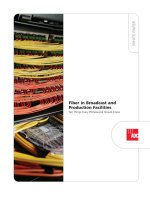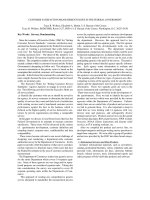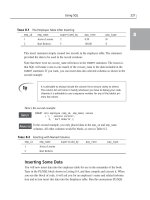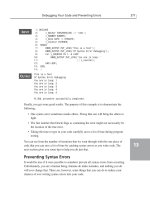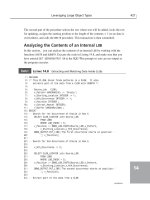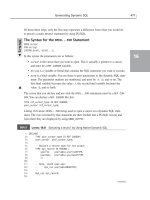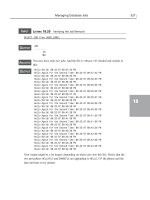Tài liệu TB Respiratory Protection Program In Health Care Facilities doc
Bạn đang xem bản rút gọn của tài liệu. Xem và tải ngay bản đầy đủ của tài liệu tại đây (807.74 KB, 120 trang )
iii
TBTB
Respiratory Protection ProgramRespiratory Protection Program
In Health Care FacilitiesIn Health Care Facilities
Administrator's GuideAdministrator's Guide
U.S. DEPARTMENT OF HEALTH AND HUMAN SERVICES
Public Health Service
Centers for Disease Control and Prevention
National Institute for Occupational Safety and Health
September 1999
iv
DDiisclasclaiimermer
Mention of any company name or product does not constitute
endorsement by the National Institute for Occupational Safety and Health.
Copies of this and other NIOSH documents are available from
National Institute for Occupational Safety and Health
Publications Dissemination
4676 Columbia Parkway
Cincinnati, OH 45226-1998
1-800-35-NIOSH (1-800-356-4674)
Fax number: (513) 533-8573
To receive other information about
occupational safety and health problems, call
1-800-35-NIOSH (1-800-356-4674), or
visit the NIOSH Web site at:
www.cdc.gov/niosh
DHHS (NIOSH) Publication No. 99-143
v
FFoorreewwoordrd
The use of respirators in the health care setting is a relatively new but im-
portant step forward in the efforts to prevent the transmission of
tuberculosis (TB). Air purifying respirators provide a barrier to prevent
health care workers from inhaling Mycobacterium tuberculosis. The level of
protection a respirator provides is determined by the efficiency of the fil-
ter material and how well the facepiece fits or seals to the health care
worker’s face. A number of studies have shown that surgical masks will
not provide adequate protection in filtering out the TB organism. Addition-
ally, surgical masks are not respirators and therefore, are not NIOSH
certified and do not satisfy OSHA requirements for respiratory protection.
The proper use of respirators represents a significant improvement in em-
ployee protection against TB. NIOSH realizes that the use of respirators
involves a number of new and perhaps confusing practices for the health
care community. This manual is designed to serve as a practical guide for
those individuals responsible for initiating and running a TB respiratory
protection program in health care facilities.
Other areas of the hospital may also require the use of respirators but the
program and respirators used may be different. If such a program exists in
your facility and has an experienced program administrator, it would be ef-
fective to administer the TB respirator program under the existing program
and use existing facilities for fit-testing, cleaning, maintenance, storage, etc.
This document is not designed to provide information on ventilation sys-
tems, negative pressure isolation rooms, and risk assessment methodologies,
which should be included in a total TB prevention program. The TB res-
pirator program described in this document does not supplant the
respirator protection program necessary for other regulated hazards (e.g.,
formaldehyde or ethylene oxide) that may be found in health care facili-
ties.
Sincerely yours,
Linda Rosenstock, M.D., M.P.H.
Director
vi
TTaableble of Contentof Contentss
Disclaimer
Foreword
Abbreviations
Acknowledgments
Introduction
Respiratory Protection Program Elements For Health Care Workers
Exposed To Tuberculosis
Respiratory Program Administration
General
NIOSH Recommended Steps for Improving the Knowledge and
Skills of the Program Administrator
Duties
Step 1 Conduct a TB Risk Assessment
Step 2 Select Respirators
Respirator Selection for Protection Against TB
Introduction
Types of Respirators for Protection Against TB
A. Disposable Particulate Respirators
B. Replaceable Particulate Respirators
C. PAPRs
D. Positive-Pressure Supplied-Air Respirators
Step 3 Write Standard Operating Procedures
Sample SOP
Step 4 Medically Screen All Users
iv
v
ix
x
1
1
2
2
2
3
4
5
5
5
7
7
8
9
10
11
12
18
vii
Step 5 Provide Training
Respirator Training Program
Introduction
Who Should Receive Respirator Training
Who Should Conduct this Training
What Should the Training Include
OSHA Training Requirements Under 29 CFR 1910.139
Tips For Training
Establish Specific Training Objectives
Make the Objectives Measurable and Observable
Make the Objectives Known to the Trainee
Actively Involve the Trainee in the Training
Allow Time for Adjustment
Provide Feedback
Provide Refresher Training
Tips For Reducing Resistance and Promoting Safety Behaviors
Safety Management
Supervisory Practices
Additional Responsibilities of the Supervisor
Environmental and Organizational Supports
Step 6 User Seal Check, Fit-Test, and Issue Respirators
Respirator Face Fitting Procedures
Fit-Testing Procedures
User seal checking Procedures
Step 7 Inspect, Clean, Maintain, and Store Respirators
Routine Respirator Inspection
Introduction
Inspection Before and After Each Use
Inspection During Cleaning
19
19
19
19
19
19
20
21
21
21
21
21
22
22
22
22
23
23
24
24
26
26
26
27
28
28
28
28
30
viii
Cleaning, Repairing, and Storing Respirators Used For Protection Against TB
Introduction
Cleaning
A. Disassembly
B. Cleaning and Sanitizing
C. Cleaning and Sanitizing Solutions
D. Loose-Fitting PAPRS
Repair
Storage
Sample SOP
Step 8 Evaluate the Program
Respirator Program Evaluation
Annual Evaluation
Additional Evaluation
References
Appendix A 1910.139 Respiratory Protection for M. tuberculosis
Appendix B OSHA Instruction CPL 2.106 (TB Enforcement)
Appendix C 1910.1020 Access to Employee Exposure and Medical Records
Appendix
D
Names and Addresses of Respirator Manufacturers and Distributors
Appendix E Respiratory Protection Checklist
Appendix F CDC Guidelines (Pages 4-6)
Appendix G Memorandum for OSHA Regional Administrators
Appendix H Appendix A to 1910.134: Fit Testing Procedure
30
30
30
31
31
31
31
31
32
33
36
36
36
36
37
38
45
62
76
82
90
93
97
ix
ACGIH American Conference of Governmental Industrial Hygienists
AFB Acid-fast bacilli
AIHA American Industrial Hygiene Association
ANSI American National Standards Institute
APF Assigned Protection Factor
ATS American Thoracic Society
cc Cubic centimeter(s)
CDC Centers for Disease Control and Prevention
CFR Code of Federal Regulations
CNC Condensation nuclei counter
CNP Controlled negative pressure
DHHS Department of Health and Human Services
FF Fit-factor
g Gram(s)
HCWs Health Care Workers
HEPA filter High-efficiency particulate air filter
hr Hour(s)
in. Inch(es)
L Liter(s)
L/min Liter(s) per minute
M. tuberculosis Mycobacterium tuberculosis
mg Milligram(s)
min Minute(s)
ml Milliliter(s)
NIOSH National Institute for Occupational Safety and Health
OSHA Occupational Safety and Health Administration
QLFT Qualitative fit-testing
QNFT Quantitative fit-testing
PAPR Powered air-purifying respirator
PEL Permissible exposure limit
PPD Purified protein derivative
RPA Respirator Program Administrator
sec Second(s)
SOPs Standard operating procedures
TB Tuberculosis
USP United States Pharmacopeia
µm Micrometer
AAbbreviationsbbreviations
x
AAcknowledgmentscknowledgments
This document was developed by Nancy Bollinger, Jeff Bryant, Walter
Ruch, Jerry Flesch, Edward Petsonk, Thomas Hodous, Brian Day, Teri
Palermo, Michael Colligan, Linda Martin, and Robert Mullan.
Technical review and assistance were provided by Larry Reed, Roland
Berry Ann, and Larry Murphy. Kim Clough, Brian Day, and Dorothy
Tan-Wilhelm produced the poster. We thank Anne Hamilton and
Chris Ellison for editing and Kim Clough for the cover design,
photography, and formatting of the document.
Cover photographs courtesy of MSA, Alpha Pro Tech, and NIOSH.
NIOSH thanks the many reviewers who helped in completing this
document, particularly the following agencies and their representa-
tives:
CDC Hospital Infections Program, Elizabeth Bolyard
CDC Division of TB Elimination, Patricia Simone
CDC National Center for Infections Disease, Walter Bond
OSHA Demetra Collia and John Steelnack
Ruby Memorial Hospital Staff
1
IIntroductionntroduction
Written Standard Operating Procedures (SOPs)
describing the selection and use of respirators
must be developed. Information and guidance
needed for the proper selection, use, and care of
these devices must be included.
Respirator selection must be based on the
hazard to which the worker is exposed. More
protective respirators may be needed for cer-
tain high-risk procedures [CDC 1994, p. 99].
The respirator user must be trained in the
correct use of the respirator as well as its
limitations. This training must include instruc-
tions for wearing and adjusting the respirator
and for checking the fit.
Respirators must be regularly cleaned and
disinfected. Disposable respirators (cannot be
used by more than one person) must be dis-
carded if they are soiled or physically dam-
aged (e.g., creased or torn). If the replaceable
filter respirator is used by more than one
person (that is, not assigned to one person
permanently), it must be cleaned and disin-
fected after each use.
Respirators must be stored in a convenient,
clean, sanitary location. They must be stored so
they are protected from dust, harmful chemi-
cals, sunlight, moisture, and excessive heat or
cold.
Respirators that are used routinely must be
inspected during cleaning, and damaged or
deteriorated parts must be replaced.
Appropriate surveillance must be maintained
for work area conditions and the degree of
worker exposure or stress. Any changes from
the last evaluation must be identified and
evaluated.
A regular inspection and evaluation (e.g.,
yearly) must be conducted to determine the
continued effectiveness of the program.
A determination must be made that a worker
Respiratory ProtectionRespiratory Protection
Program Elements For HealthProgram Elements For Health
Care Workers Exposed ToCare Workers Exposed To
TuberculosisTuberculosis
From 1985 to 1992, the incidence of turberculosis (TB)
in the general U.S. population increased approxi-
mately 14 percent, reversing a 30-year downward
trend. In 1993, 25,313 new cases of TB were reported
in the U.S. [CDC 1994]. Associated with this resur-
gence were hospital outbreaks of TB, and the emer-
gence of multiple-drug-resistant TB. In response to
these public health threats, extensive efforts were
taken across the nation to improve TB-prevention and
TB-control programs. As a result of these measures,
since 1992, there has been a consistent decline in the
number and incidence of TB (i.e., 7.4 cases per 100,000
population and 19,855 total cases in 1997) and a
decline in multiple-drug-resistant TB [CDC 1998b].
The public health and the occupational risks of TB
thus appear to be once again decreasing, but they
remain very significant.
* Code of Federal Regulations. See CFR in references.
+ [29 CFR 1910.139] was formerly codified at [29 CFR 1910.134].
Health care workers exposed to patients with infec-
tious TB require protection from that disease. Be-
cause the use of engineering controls (such as isola-
tion rooms and ventilation) may not completely
control the TB hazard, respiratory protection is
needed.
When respirators are used, the Occupational Safety
and Health Administration (OSHA) standard for
respiratory protection for M. tuberculosis [29 CFR*
1910.139]
+
must be followed. OSHA has stated that
it will promulgate a separate standard for TB; but
until then, the use of respirators for TB exposures
will be enforced under the original respiratory
protection program prescribed by OSHA in 29 CFR
1910.139 (see Appendix A). This program requires
the following:
2
NIOSH Recommended NIOSH Recommended Steps forSteps for
Improving the Knowledge Improving the Knowledge and and SkillsSkills
of the Program Administratorof the Program Administrator
Become completely familiar with and un-
derstand the OSHA respirator standard.
Also understand standards, interpreta-
tion letters, and field manuals which
provide interpretation and inspection
methods used by OSHA inspectors (see
Appendix B).
Attend a respirator course given by com-
mercial vendors and NIOSH Educational
Resource Centers.
Obtain materials from respirator manufac-
turers. These include VCR tapes, slide
shows, publications, etc.
Read and understand the NIOSH Guide to
Industrial Respiratory Protection [Bollinger
and Schutz 1987], the American National
Standard for Respiratory Protection [ANSI
Z88.2-1992], the American Industrial Hy-
giene Association Respiratory Protection
Manual [AIHA 1993], and the Centers for
Disease Control and Prevention (CDC) Guide-
lines for Preventing the Transmission of My-
cobacterium tuberculosis in Health-Care
Facilities [CDC 1994].
Read respirator articles in the American
Industrial Hygiene Association Journal, Ap-
plied Occupational and Environmental Hy-
giene, and other journals. The Internet may
also be a source of information.
Read books on respiratory protection
available from The American Industrial
Hygiene Association (AIHA), The Ameri-
can Conference of Governmental Indus-
trial Hygienists (ACGIH), and others.
Visit installations (health care and others)
that have ongoing respiratory protection
programs.
For a respirator program to be properly estab-
lished and effective on a continuing basis,
written SOPs must be established. One person
(the program administrator) must be in charge
of the program and be given the authority and
responsibility to manage all aspects of the
program. The administrator must have suffi-
cient knowledge (obtained by training or
experience) to develop and implement a respi-
ratory protection program. Preferably, he or
she should have a background in industrial
hygiene, safety, health care, or engineering.
The program administrator should report to
the highest official possible (manager of the
safety department, supervisor of nurses,
worker health manager, infection control
manager, etc.) and should be given sufficient
time to administer the respirator program in
addition to any other duties assigned.
GeneralGeneral
RespiratorRespirator ProgramProgram AdministrationAdministration
NOTE: Each of these requirements will be addressed in
more detail throughout this document.
is physically able to safely do the work while
using the respiratory protection equipment.
The physician must determine what health and
physical conditions are pertinent. The
respirator user's medical status should be
reviewed periodically (e.g., annually).
Respirators must be selected from those
approved by the National Institute for Occupa-
tional Safety and Health (NIOSH) under the
provisions of 42 CFR 84 or 30 CFR 11 (high-
efficiency particulate air [HEPA] filter only).
If a health care facility uses respirators for
worker protection against other regulated haz-
ards (e.g., formaldehyde, ethylene oxide, etc.),
then a respirator program must be imple-
mented for these hazards that incorporate all
the requirements of OSHA standard 1910.134.
3
Remember: Everything concerning the respira-
tor program must be written.
N95 Disposable RespiratorN95 Disposable Respirator
N95 Disposable RespiratorN95 Disposable Respirator
N95 Disposable Respirator
Photo courtesy of Geiss.Photo courtesy of Geiss.
Photo courtesy of Geiss.Photo courtesy of Geiss.
Photo courtesy of Geiss.
DutiesDuties
DutiesDuties
Duties
The administrator must be responsible for the
entire program and ensure that the program is
written, reviewed, and implemented.
The ad-
ministrator should:
Develop a written policy statement show-
ing that the employer is responsible for
providing a safe and healthful workplace.
For example: The management of this fa-
cility is responsible for providing a safe
workplace for its workers and for supply-
ing respirators and any other materials
necessary to provide such an environ-
ment.
Develop a policy detailing the workers' re-
sponsibility to follow all written policies and
the consequences of not following them. For
example, the workers are responsible for
following all procedures and written policies
developed by the program manager; work-
ers violating these policies may need to be
retrained and provided with positive feed-
back to improve adherence to the policies.
Provide a written program showing re-
sponsibility, accountability, and author-
ity for conducting the program and indi-
cate the person delegated to conduct
parts of the program.
Review the TB risk assessment regularly
to determine whether conditions have
changed. CDC recommends that this
review be conducted at least yearly in
minimal-, very low-, and low-risk cat-
egories; every 6-12 months for intermedi-
ate-risk categories; and every 3 months
in high-risk categories [CDC 1994, pp. 8-
23].
Determine what types and brands of respi-
rators to purchase.
Designate an area or areas staffed to main-
tain, issue, and fit-test respiratory protec-
tive equipment.
Develop administrative procedures for the
purchase of approved respirators and for
inventory control of spare parts, if needed.
Ensure that only NIOSH-certified respira-
tors are purchased and used.
Determine what records need to be kept,
where to keep them, and how long to keep
them. Consider the type of records that
need to be maintained to demonstrate
compliance with OSHA standards and to
satisfy any legal considerations. The ad-
ministrator should follow the provisions of
29 CFR 1910.1020 OSHA's rule on Access
to Employee Exposure and Medical Records
(See Appendix C).
Write and/or approve all SOPs (SOPs
will be addressed later in more detail).
4
SStep 1 Conduct a TB Risk Assessmenttep 1 Conduct a TB Risk Assessment
Conduct a risk assessment for the entire facility
and for specific areas within the facility. The
elements of the risk assessment are included
below for complete information on how to con-
duct the assessment. Perform a follow-up risk
assessment at the intervals indicated by the most
recent risk assessment [CDC 1994, Figure 1,
Table 2]. Determine who must wear a respirator
and be included in the program.
1.
Review the community TB profile
(from public health department data).
2. Review the number of TB patients
who were treated in each area of the
facility (both inpatient and outpatient).
(This information can be obtained by
analyzing laboratory surveillance data
and by reviewing discharge diagnoses or
medical and infection-control records.)
3. Review the drug-susceptibility pat-
terns of TB isolates of patients who were
treated at the facility.
4. Analyze purified protein derivative
(PPD)-tuberculin skin-test results of
health care workers (HCWs), by area or
by occupational group for HCWs not
assigned to a specific area (e.g., respira-
tory therapists).
5.
To evaluate infection-control param-
eters, review medical records of a sample
of TB patients seen at the facility.
Calculate intervals from:
admission until TB suspected;
admission until TB evaluation
performed;
admission until acid-fast bacilli (AFB)
specimens ordered;
AFB specimens ordered until AFB
specimens collected;
AFB specimens collected until AFB
smears performed and reported;
AFB specimens collected until cultures
performed and reported;
AFB specimens collected until species
identification conducted and reported;
AFB specimens collected until drug-
susceptibility tests performed and
reported;
admission until TB isolation initiated;
admission until TB treatment initiated;
and duration of TB isolation.
Obtain the following additional information:
Were appropriate criteria used for dis-
continuing isolation?
Did the patient have a history of prior
admission to the facility?
Was the TB treatment regiment
adequate?
Were follow-up sputum specimens
collected properly?
Was appropriate discharge planning
conducted?
6. Perform an observational review of TB
infection control practices.
7. Review the most recent environmental
evaluation and maintenance procedures.
Copies of the Morbidity and Mortality Weekly
Report (October 28, 1994/Vol. 43/No. RR-13)
entitled "Guidelines for Preventing the Transmis-
sion of Mycobacterium tuberculosis in Health Care
Facilities, 1994" may be obtained by calling
1-800-843-6356 or is available through the CDC
homepage at .
TABLE 1. Elements of a risk assessment
for tuberculosis (TB) in health care facili-
ties (Reprinted from [CDC 1994, page 8])
5
collected, the precise level of effectiveness
in protecting HCWs [health care workers]
from M. tuberculosis transmission in health
care settings has not been determined. In-
formation concerning the transmission of
M. tuberculosis is incomplete. Neither the
smallest infectious dose of M. tuberculosis
nor the highest level of exposure to M. tu-
berculosis at which transmission will not oc-
cur has been defined conclusively (59, 151,
152). Furthermore, the size distribution of
droplet nuclei and the number of particles
containing viable M. tuberculosis that are ex-
pelled by infectious TB patients have not
been defined adequately, and accurate
methods of measuring the concentration of
infectious droplet nuclei in a room have not
been developed.
Nevertheless, in certain settings the admin-
istrative and engineering controls may not
adequately protect HCWs from airborne
droplet nuclei (e.g., in TB isolation rooms,
treatment rooms in which cough-inducing
or aerosol-generating procedures are per-
formed, and ambulances during the trans-
port of infectious TB patients). Respiratory
protective devices used in these settings
should have characteristics that are suitable
for the organism they are protecting against
and the settings in which they are used.
A. Performance Criteria for Personal
Respirators for Protection Against
Transmission of M. tuberculosis
Respiratory protective devices used in
health care settings for protection against
M. tuberculosis should meet the following
standard criteria. These criteria are based
on currently available information, includ-
ing a) data on the effectiveness of respira-
tory protection against noninfectious
hazardous materials in workplaces other
than health care settings and on an inter-
SStep 2 Select Respiratorstep 2 Select Respirators
IntroductionIntroduction
Surgical masks are not respirators and are not certi-
fied as such; they do not protect the user adequately
from exposure to TB. Disposable respirators (e.g.,
N-95s) are commonly used in TB isolation rooms,
in transport of TB cases, or in other areas of the
health care facility. However, when high-risk pro-
cedures such as bronchoscopy or autopsy are con-
ducted, respiratory protection exceeding the CDC
standard performance criteria may be needed.
This protection includes full facepiece negative-pres-
sure respirators, powered air-purifying respirators
(PAPRs), or positive-pressure airline respirators
equipped with a half-mask or full facepiece.
In addition, individual medical conditions such as
latex allergy, can influence respirator selections. La-
tex-free respirators are available.
Additional information is provided below.
I. Consideration for Selection of Respirators
Personal respiratory protection should be used
by a) persons entering rooms where patients
with known or suspected infectious TB are be-
ing isolated, b) persons present during cough-
inducing or aerosol-generating procedures per-
formed on such patients, and c) persons in other
settings where administrative and engineering
controls are not likely to protect them from in-
haling infectious airborne droplet nuclei. These
other settings should be identified on the basis
of the facility’s risk assessment.
Although data regarding the effectiveness
of respiratory protection from many haz-
ardous airborne materials have been
Supplement 4: Respiratory Protection
(Reprinted from [CDC 1994, Page 97])
Respirator Selection For ProtectionRespirator Selection For Protection
Against TBAgainst TB
6
pretation of how these data can be ap-
plied to respiratory protection against M.
tuberculosis; b) data on the efficiency of
respirator filters in filtering biological
aerosols; c) data on face-seal leakage; and
d) data on the characteristics of respira-
tors that were used in conjunction with
administrative and engineering controls
in outbreak settings where transmission to
HCWs and patients was terminated.
1. The ability to filter particles 1 µm in size
in the unloaded state with a filter efficiency
of > 95% (i.e., filter leakage < of 5%), given
flow rates of up to 50 L per minute.
Available data suggest that infectious
droplet nuclei range in size from 1 mm to 5
mm; therefore, respirators used in health
care settings should be able to efficiently
filter the smallest particles in this range.
Fifty liters per minute is a reasonable
estimate of the highest airflow rate an
HCW is likely to achieve during breathing,
even while performing strenuous work
activities.
2. The ability to be qualitatively or quanti-
tatively fit tested in a reliable way to
obtain a face-seal leakage of < 10% (54,
55).
3. The ability to fit the different facial sizes
and characteristics of HCWs, which can
usually be met by making the respirators
available in at least three sizes.
4. The ability to be checked for facepiece
fit, in accordance with OSHA standards
and good industrial hygiene practice, by
HCWs each time they put on their
respirators (54, 55).
In some settings, HCWs may be at risk for
two types of exposure: a) inhalation of M.
tuberculosis and b) mucous membrane
exposure to fluids that may contain
bloodborne pathogens. In these settings,
protection against both types of exposure
should be used.
When operative procedures (or other proce-
dures requiring a sterile field) are per-
formed on patients who may have infec-
tious TB, respiratory protection worn by the
HCW should serve two functions: a) it
should protect the surgical field from the
respiratory secretions of the HCW and b) it
should protect the HCW from infectious
droplet nuclei that may be expelled by the
patient or generated by the procedure. Res-
pirators with expiration valves and posi-
tive-pressure respirators do not protect the
sterile field; therefore, a respirator that does
not have a valve and that meets the criteria
in Supplement 4, Section I.A, should be
used.
References reprinted from supplement
4 [CDC 1994, page 108 & page 112]
54. American National Standards
Institute. American national stan-
dard practices for respiratory pro-
tection. New York: American
National Standards Institute, 1992.
55. NIOSH. Guide to industrial respi-
ratory protection. Morgantown,
WV: US Department of Health and
Human Services, Public Health Ser-
vice, CDC, 1987; DHHS publica-
tion no. (NIOSH)87-116.
59. CDC/National Institutes of Health.
Agent: Mycobacterium tuberculosis,
M. bovis. In: Biosafety in microbio-
logical and biomedical laboratories.
Atlanta: US Department of Health
and Human Services, Public Health
Service, 1993:95; DHHS publica-
tion no. (CDC)93-8395.
7
NOTE: Allow users to choose from a variety of
respirators (several manufacturers and sizes) to
obtain the best and most comfortable fit possible.
§
The minimum level of respiratory protection for
TB recommended by NIOSH is the N-95 half-
mask respirator.
A. Disposable Particulate Respirators
The NIOSH-certified disposable respirators
labeled N, R, or P meet CDC criteria and may
be obtained with or without exhalation valves.
Most manufacturers also produce them in
different sizes. A face shield may also be used
in conjunction with a half-mask disposable
respirator for protection against body fluids.
Advantages
1.
The respirator is disposable and most mod-
els require no cleaning or maintenance
(See page 28).
2. The respirator is light weight and fairly
comfortable to wear.
Disadvantages
1.
The respirator is a negative-pressure device
using the suction produced by inhalation to
draw air through the filter. The inhalation
process, even under the best of circumstances,
will allow some contaminated air to leak into
the facepiece.
2. A respirator with exhalation valves cannot
be used when working in a sterile field such
as an operating room. The exhalation valve
allows droplets and particles exhaled by the
user to escape and potentially contaminate
the surgical field. These respirators are also
available without exhalation valves.
151. Bloom BR, Murray CJL. Tubercu-
losis: commentary on a reemergent
killer. Science 1992;257:1055-64.
152. Nardell EA. Dodging droplet nuclei:
reducing the probability of nosoco-
mial tuberculosis transmission in the
AIDS era. Am Rev Respir Dis
1990;142:501-3.
Disposable
Particulate
Respirator with
adjustable straps
and exhalation
valve.
Photo courtesy
of MSA.
Disposable
Particulate
Respirator.
Photo courtesy of
Alpha Pro Tech.
Disposable
Particulate
Respirator with
fixed straps and no
exhalation valve.
Photo courtesy of
MSA.
Types of Respirators for ProtectionTypes of Respirators for Protection
Against TBAgainst TB
§See Appendix D for a list of manufacturers.
References from supplement 4 continued
8
The full facepiece respirator also meets CDC
requirements for respiratory protection against
exposure to TB. The respirator can be equipped
with the N, R, or P filters (HEPA filters can
also be used). It is also manufactured in more
than one size.
B. Replaceable Particulate Filter
Respirators
The half-mask respirator also meets CDC
requirements. This respirator has single or dual
filters made of the same material as the N, R, and P
disposable respirators (HEPA filters can also be
used). Most manufacturers produce more than one
size. A face shield may also be used in conjunction
with a half-mask particulate filter respirator for
protection against body fluids.
Full Facepiece Replaceable Particulate
Filter Respirator
Half-Mask Replaceable Particulate
Filter Respirator
Advantages
1. The respirator provides a better seal than
the half-mask and with HEPA or 100 series
filter is more protective.
2. The respirator is durable.
3. The respirator provides eye protection.
Disadvantages
1.
The respirator cannot be used in areas
where a sterile field is required.
2. The respirator must be inspected, cleaned,
and repaired.
3.
The respirator is a negative-pressure device
using the suction produced by inhalation to draw
air through the filter. The inhalation process, even
NOTE: Manufacturer A’s small size is not
necessarily the same as Manufacturer B’s small size.
Advantages
1.
The respirator is lightweight and does not
restrict mobility.
2. The respirator is made of rubber or elastomer
and is durable. Only the filters need to be
replaced when necessary.
Disadvantages
1.
The respirator must be routinely inspected,
cleaned, disinfected, and repaired (See Step 7).
2. The respirator is a negative-pressure device
using the suction produced by inhalation to
draw air through the filter. The inhalation
process, even under the best of circumstances,
will allow some contaminated air to leak into the
facepiece.
3. Communication may be difficult.
4. The respirator cannot be used in areas where a
sterile field is required (surgical suite).
Half-Mask Replaceable Particulate Filter Respirator.
Photo (left) courtesy of Neoterik Health Technologies
Inc. Photo (right) courtesy of NIOSH.
Full Facepiece
Replaceable
Particulate Filter
Respirator.
Photo courtesy of
NIOSH.
9
C. PAPRs
Tight-Fitting PAPR
These respirators also meet CDC guidelines for
protection against TB exposure. The equipment
is battery operated, consists of a half or full
facepiece, breathing tube, battery-operated
blower, and particulate filters (HEPA only). A
PAPR uses a blower to pass contaminated air
through a HEPA filter, which removes the con-
taminant and supplies purified air to a facepiece.
A PAPR is not a true positive-pressure device be-
cause it can be over-breathed when inhaling. A
face shield may also be used in conjunction with
a half-mask PAPR respirator for protection
against body fluids.
Advantages
1.
The respirator is more protective than a
half-mask respirator.
2. The respirator is usually more comfortable
because air is forced into the mask by the
blower, producing a cooling effect.
3. The respirator is durable.
4. Breathing resistance is lower.
Disadvantages
1. The respirator cannot be used where a
sterile field is required because it has an
exhalation valve and in some cases air can exit
around the face seal.
2. Batteries must be recharged and maintained
to assure proper flow rates into the mask.
3.
The respirator must be inspected, cleaned,
and repaired.
4. Communication may be a problem.
5. A PAPR may be bulky and noisy.
Loose Fitting PAPR
This respirator consists of a hood or helmet,
breathing tube, battery-operated blower, and
HEPA filters. It meets CDC guidelines.
Advantages
1. More protective than a half-mask respirator.
2.
The respirator is more comfortable because
it is loose-fitting.
3.
Provides a cooling effect in the hood or
helmet.
Tight-Fitting PAPR.
Photo courtesy
of NIOSH.
Loose-Fitting PAPR.
Photo courtesy of
Neoterik Health
Technologies Inc.
under the best of circumstances, will allow some
contaminated air to leak into the facepiece.
4.
Communication may be difficult.
5. Special lens kits are required for those
respirator users who wear glasses.
4. The respirator is du-
rable.
5.
Breathing resistance
is lower.
6.
Vision may be better.
10
Advantages
1.
The respirator is much more protective be-
cause it provides positive pressure in the
facepiece and almost all leakage is outward.
A positive-pressure supplied-air respirator
should be used when disposable respirators,
replaceable respirators, or PAPRs do not pro-
vide adequate protection.
2. Breathing resistance is minimal.
3.
The respirator is relatively comfortable to
wear.
D. Positive-Pressure Supplied-Air
Respirators
Supplied-air respirators use compressed air
from a stationary source delivered through a
hose under pressure to a half-mask or a full
facepiece. A face shield may also be used in
conjunction with a half-mask airline respirator
for protection against body fluids.
Positive-Pressure
Supplied-Air
Respirators.
Photo courtesy of
NIOSH.
7.
Can be worn with facial hair as long as facial
hair does not interfere with valve or function of
the respirator.
Disadvantages
1. The equipment cannot be used where a ster-
ile field must be maintained because air exits
around the hood or helmet.
2.
Batteries must be charged and maintained.
3.
The respirator must be inspected, cleaned,
and repaired.
4.
Communication may be difficult.
5.
A PAPR may be bulky and noisy.
Disadvantages
1.
The airline hose restricts the user’s mobility.
2.
This respirator exhausts air contaminated
by the user and should not be worn during
sterile procedures.
3.
The respirator must be inspected, cleaned,
and repaired.
4.
Communication may be difficult.
5. Requires installation and maintenance of a
regulated compressed air supply for Grade D
breathing air.
6. Maintenance requires highly skilled, tech-
nically trained personnel.
7. Length of hose and connection point must
be adequate to prevent exposure to TB when
removing the respirator.
11
1. Administrative procedures:
A. Employer responsibilities
B. Employee responsibilities
C. Purchase of certified respirators
D. Inventory control
E. Issuance of respirators
F. Special problems (beards, etc.)
2. Respirator selection
3. Medical surveillance
4. Respirator training program
5. Respirator face-fitting procedures
6. Maintenance procedures:
A. Cleaning and sanitizing
B. Inspection
C. Repair
D. Storage
7. Program evaluation
Guidance for an SOP follows on the next
page. Additional information on SOPs may
also be available from the manufacturer of
the respirator.
SStep 3 Write Standard Operating Procedurestep 3 Write Standard Operating Procedures
The importance of written Standard Operating
Procedures (SOPs) is emphasized by OSHA in
29 CFR Part 1910.139 which specifies the first
requirement for a “minimal acceptable (respira-
tor) program” as establishment of written SOPs
governing the selection and use of respirators.
Part 1910.139 does not provide any guidance
for preparing these procedures and does not
differentiate between large and small users.
An SOP is a detailed written procedure that de-
scribes an operation so thoroughly that it can be
accomplished repeatedly and can consistently
arrive at the same end point. No room for in-
terpretation exists. The SOPs should contain all
information needed to maintain an effective res-
pirator program to meet the user’s individual
requirements. SOPs should be written to be
useful to those directly involved in the respira-
tor program, the program administrator, those
fitting the respirators and training the workers,
respirator maintenance workers, and the super-
visors responsible for overseeing respirator use
on the job. Generally, the procedures should
cover the following topics:
Photo courtesy of Racal Health & Safety, Inc.
12
Purpose:
The purpose of this standard operating procedure is to ensure the protection of all employees from
respiratory hazards caused by exposure to TB, through the proper use of respirators.
Responsibility:
The Respirator Program Administrator (RPA) is _________________________________. She/he is
solely responsible for all aspects of this program and has full authority to make the necessary decisions to
ensure its success. This authority includes (but is not limited to) hiring personnel, purchasing the
necessary equipment to implement the program, and operate the respiratory protection program. The RPA
(or designee) will develop written detailed instructions covering each of the basic elements in this
program, and is the only person authorized to amend these instructions.
The ABC health care facility has expressly authorized the RPA to audit and change respirator usage
procedures whenever there is a chance of exposure to TB. This includes designating mandatory respirator
usage areas.
Program Elements:
1. The RPA (or designee) will develop detailed written standard operating procedures governing the
selection and use of respirators, using the OSHA regulations and the NIOSH Respirator Decision Logic
as guidelines. Outside consultation, manufacturers assistance, and other recognized authorities will be
consulted if there is any doubt regarding proper selection and use of respirators. These detailed
procedures will be included as appendices to this respirator program. Only the RPA may amend these
procedures.
2. Respirators will be selected on the basis of CDC guidelines. All selections will be made by the RPA
(or designee). Only NIOSH certified respirators will be selected and used.
3. The user will be instructed and trained in the proper use of respirators and their limitations. Both
supervisors and workers will be trained by the RPA (or designee). The training should provide the
employee an opportunity to handle the respirator, have it fitted properly, test its facepiece-to-face seal,
wear it in normal air for a long familiarity period, and finally to wear it in a test atmosphere. Every
respirator wearer will receive fitting instructions, including demonstrations and practice in how the
respirator should be worn, how to adjust it, and how to determine if it fits properly.
Respirators should not be worn when conditions prevent a good face seal. Such conditions may be a
growth of beard, sideburns, a skull cap that projects under the facepiece, or temple pieces on glasses.
No employees of this facility, who are required to wear tight fitting respirators may wear beards. Also
the absence of one or both dentures can seriously affect the fit of a facepiece. The workers diligence in
observing these factors will be evaluated by periodic checks. To assure proper protection, the user seal
check will be done by the wearer each time she/he puts on the respirator. The manufactures instructions
will be followed.
ABC Health Care Facility
Respiratory Protection Program
13
4. Where practicable, the respirators will be assigned to individual workers for their exclusive use.
5. Nondisposable respirators will be regularly cleaned and disinfected. Those issued for the
exclusive use of one worker will be cleaned after each days use, or more often if necessary. Those
used by more than one worker will be thoroughly cleaned and disinfected after each use. The RPA
will establish a respirator cleaning and maintenance facility and develop detailed written cleaning
instructions.
Disposable respirators will be discarded if they are soiled or are no longer functional. See the
manufacturers instructions.
6. The central respirator cleaning and maintenance facility will store respirators in a clean and
sanitary location.
7. Respirators used routinely will be inspected during cleaning. Worn or deteriorated parts will be
replaced.
8. Appropriate (e.g., quarterly) surveillance of work area conditions and degree of employee exposure
will be maintained.
9. There will be regular (e.g., annually) inspections and evaluations to determine the continued
effectiveness of the program. The RPA will make frequent inspections of all areas where
respirators are used to ensure compliance with the respiratory protection programs.
10. Persons will not be assigned to tasks requiring use of respirators unless it has been determined that
they are physically able to perform the work and use the equipment. The ABC health care facility
physician will determine what health and physical conditions are pertinent. The respirator users
medical status will be reviewed annually.
11. NIOSH certified respirators will be used.
Respirator Program Evaluation Checklist
In general, the respiratory protection program should be evaluated for each job or at least annually, with
program adjustments, as appropriate, made to reflect the evaluation results. Program function can be
separated into administration and operation.
A. Program Administration
____________ (1) Is there a written policy which acknowledges employer responsibility for
providing a safe and healthful workplace, and assigns program responsibility,
accountability, and authority?
____________ (2) Is program responsibility vested in one individual who is knowledgeable and
who can coordinate all aspects of the program at the health care facility?
14
____________ (3) Can administrative and engineering controls eliminate the need for respirators?
____________ (4) Are there written procedures/statements covering the various aspects of the
respirator program, including:
____________ (a) designation of an administrator;
____________ (b) respirator selection;
____________ (c) purchase of NIOSH certified respirators;
____________ (d) medical aspects of respirator usage;
____________ (e) issuance of equipment;
____________ (f) fitting;
____________ (g) training;
____________ (h) maintenance, storage, and repair;
____________ (i) inspection;
____________ (j) use under special conditions; and
____________ (k) work area surveillance?
B. Program Operation
(1) Respiratory protective equipment selection
____________ (a) Are work area conditions and worker exposures properly surveyed?
____________ (b) Are respirators selected on the basis of the hazard to which the worker
is exposed?
____________ (c) Are selections made by individuals knowledgeable in proper selection
procedures?
____________ (2) Are only NIOSH certified respirators purchased and used; do they provide
adequate protection for the specific hazard?
____________ (3) Has a medical evaluation of the prospective user been made to determine
physical and psychological ability to wear the selected respiratory protective
equipment?
____________ (4) Where practical, have respirators been issued to the users for their exclusive
use, and are there records covering issuance?
(5) Respiratory protective equipment fitting
____________ (a) Are the users given the opportunity to try on several respirators to
determine whether the respirator they will be subsequently wearing is the
best fitting one?
____________ (b) Is the fit tested at appropriate intervals?
15
____________ (c) Are those users who require corrective lenses properly fitted?
____________ (d) Is the facepiece-to-faceseal tested in a test atmosphere?
____________ (e) Are workers prohibited from wearing respirators in contaminated
work areas when they have facial hair or other characteristics which
may cause faceseal leakage?
(6) Respirator use in the work area
____________ (a) Are respirators being worn correctly (i.e., head covering over respirator
straps)?
____________ (b) Are workers keeping respirators on all the time while in the designated
areas?
(7) Maintenance of respiratory protective equipment
Cleaning and Disinfecting
____________ (a) Are nondisposable respirators cleaned and disinfected after each use
when different people use the same device, or as frequently as necessary for
devices issued to individual users?
____________ (b) Are proper methods of cleaning and disinfecting utilized?
Storage
____________ (a) Are respirators stored in a manner so as to protect them from dust,
sunlight, heat, damaging chemicals, or excessive cold or moisture?
____________ (b) Are respirators stored in a storage facility so as to prevent them from
deforming?
____________ (c) Is storage in lockers permitted only if the respirator is in a carrying case
or carton?
Inspection
____________ (a) Are respirators inspected before and after each use and during cleaning?
____________ (b) Are qualified individuals/users instructed in inspection techniques?
16
____________ (c) Are records kept of the inspection of respiratory protective equipment?
Repair
____________ (a) Are replacement parts used in repair those of the manufacturer of the
respirator?
____________ (b) Are repairs made by trained individuals?
(8) Training and Feedback
____________ (a) Are users trained in proper respirator use, cleaning, and inspection?
____________ (b) Are users trained in the basis for selection of respirators?
____________ (c) Are users evaluated, using competency-based evaluation, before and
after training?
____________ (d) Are users periodically consulted about program issues (e.g., discomfort,
fatigue, etc.)
17
SAMPLE RESPIRATOR INSPECTION RECORD
1. TYPE_________________________________________ 2. NO._______________________
3. DATE:_____________________________________________________________________
A. Facepiece
B. Inhalation Valve
C. Exhalation Valve Assembly
D. Headbands / Straps
E. Filter Cartridge
F. Cartridge/Canister
G. Harness Assembly
H. Hose Assembly
I. Speaking Diaphragm
J. Gaskets
K. Connections
L. Other Defects
DEFECTS FOUND CORRECTIVE ACTION
